The material below was written by the ChatGPT program. Do not take it at face value. ChatGPT often writes something that’s incorrect, but sounds convincing. This is because the AI model is being used to generate semi-random text that conforms to patterns in existing texts. It also appears to have a level of conceptual abstraction to constrain the texts, but this also seems to create statements where texts contradict fact.
There are several scholars who have written about the relationship between neoliberalism and the national question in the late 20th century. Some examples include:
- David Harvey – Harvey is a Marxist geographer who has written extensively on neoliberalism and its impact on urbanization, social movements, and the national question. In particular, he has argued that neoliberalism has intensified existing inequalities and divisions within and between nations, and has led to the resurgence of nationalist and populist movements.
- Eric Hobsbawm – Hobsbawm was a Marxist historian who wrote about the rise of nationalism and the challenges it posed to socialism in the late 20th century. He argued that the collapse of the Soviet Union and the rise of neoliberal globalization had created a vacuum that was filled by nationalist movements and ideologies.
- Michael Hardt and Antonio Negri – Hardt and Negri are political theorists who have written about globalization and its impact on the nation-state and national identity. They argue that neoliberal globalization has weakened the power of the nation-state and created new forms of transnational political and economic organization, but that national identity and resistance to globalization persist.
- Benedict Anderson – Anderson was a political scientist who wrote about nationalism and its relationship to modernity and the nation-state. His influential book “Imagined Communities” argues that national identity is a socially constructed phenomenon that is rooted in the development of modern communication technologies and the rise of print capitalism.
These are just a few examples of scholars who have written about the relationship between neoliberalism and the national question in the late 20th century. Other notable scholars in this field include Saskia Sassen, Arjun Appadurai, and Fredric Jameson, among many others.
Interested in Marxism, Socialism, or Anarchism? Join a Book Club!
LA Peace and Freedom Book Club
Black Reconstruction Reading Group
what is the role of asian and indian labor in the carribbean as a comprador class
The concept of the “comprador class” is a Marxist term that refers to a social group in a colonized or semi-colonized country that serves as intermediaries between foreign imperial powers and the domestic population. The term has been applied to various groups, including local elites, merchants, and bureaucrats, who are seen as collaborators with foreign powers and who benefit from their presence in the region.
While some scholars have argued that Asian and Indian laborers in the Caribbean can be seen as a comprador class, this view is not universally accepted. It is true that Asian and Indian laborers were brought to the Caribbean by European colonial powers as part of a broader strategy to maintain control over their colonies, and that they were often exploited and marginalized by these powers. However, the idea that they served as intermediaries between foreign powers and the domestic population is more contentious.
One reason for this is that Asian and Indian laborers in the Caribbean were often brought to the region as indentured laborers, with limited opportunities for upward mobility. While some individuals were able to establish themselves as merchants or businesspeople, many others remained in low-paying jobs and faced discrimination and marginalization.
Additionally, the experiences of Asian and Indian laborers in the Caribbean varied widely depending on the country and the time period. In some cases, they were able to form strong communities and develop their own cultural and economic institutions. In other cases, they faced hostility and violence from the local population and were excluded from mainstream society.
Overall, while it is true that Asian and Indian laborers in the Caribbean were brought to the region as part of a broader strategy of imperial control, the extent to which they can be seen as a comprador class is a matter of debate among scholars.
Induct Leslie Kong into the Rock and Roll Hall of Fame!
is the model minority myth similar to the idea of a comprador class
The model minority myth and the concept of a comprador class are related in the sense that they both describe groups that are seen as intermediaries between dominant powers and subordinate groups. However, they differ in some important ways.
The model minority myth is a term that refers to the idea that certain minority groups, particularly Asian Americans, are successful and high-achieving in areas such as education, income, and professional success, and that their success is due to cultural values such as hard work and perseverance. This myth is often used to downplay the effects of racism and discrimination on minority groups, and to argue that these groups can achieve success if they simply work hard enough.
In contrast, the concept of a comprador class refers to a social group in a colonized or semi-colonized country that serves as intermediaries between foreign imperial powers and the domestic population. This group is seen as collaborating with foreign powers and benefiting from their presence in the region, often at the expense of the local population.
While both the model minority myth and the concept of a comprador class involve ideas of social hierarchy and collaboration with dominant powers, the model minority myth is more focused on individual achievement and the downplaying of systemic racism, while the concept of a comprador class is more focused on the structural relationships between dominant and subordinate groups. Additionally, while the model minority myth is often applied to Asian Americans in the United States, the concept of a comprador class is more commonly used to describe groups in colonized or semi-colonized countries.
can a comprador class exist within a non-colony independent state?
The term “comprador class” typically refers to a social class that emerged in colonial or semicolonial societies, in which a small group of indigenous people acted as intermediaries between the colonizers and the local population. They were often involved in trade, commerce, and other economic activities, and were seen as collaborators with the colonial powers.
In the context of a non-colonial, independent state, the dynamics of social and economic class may be different. It is possible that there could be a similar class of people who act as intermediaries between foreign investors or corporations and the local population, but they may not necessarily be called a “comprador class” as the term is specifically associated with colonialism.
In general, the dynamics of class and social hierarchy are complex and depend on a variety of factors, such as history, culture, politics, and economics. So it’s possible for certain classes of people to emerge in different contexts, but their specific characteristics and roles may vary.
what is the concept of an internal colony?
The concept of an “internal colony” refers to a situation in which a group of people within a country are treated as if they were a colonized people, even though they are technically part of the same political entity as the colonizers. This term is often used to describe the historical and ongoing oppression of certain groups within a country, such as indigenous peoples, African Americans in the United States, or the Irish in Northern Ireland.
The idea of internal colonization suggests that there are similarities between the way that colonizers treat the colonized and the way that dominant groups within a country treat marginalized groups. For example, both colonizers and dominant groups may use violence, economic exploitation, cultural suppression, and other forms of oppression to maintain their power and control over the colonized or marginalized group.
The concept of an internal colony has been used by scholars, activists, and social movements to draw attention to the ongoing struggles of marginalized groups within a country and to argue for greater recognition of their rights and autonomy.
who wrote about internal colonialization in the united states?
There are several scholars who have written about the concept of internal colonialism in the United States. Some of the notable writers on this topic include:
- Robert Blauner – In his 1972 book “Racial Oppression in America”, Blauner introduced the concept of “internal colonialism” as a way to describe the historical and ongoing oppression of African Americans in the United States.
- Michael Omi and Howard Winant – In their influential 1986 book “Racial Formation in the United States”, Omi and Winant built on Blauner’s work and developed a theory of racial formation that included the idea of internal colonialism as one of its key concepts.
- Roxanne Dunbar-Ortiz – In her 2014 book “An Indigenous Peoples’ History of the United States”, Dunbar-Ortiz argues that indigenous peoples in the United States have been subjected to a form of internal colonialism since the arrival of Europeans on the continent.
- Frantz Fanon – Although not specifically writing about the United States, Fanon’s work on colonialism and decolonization has been influential in shaping discussions of internal colonialism in many contexts, including the United States. His book “The Wretched of the Earth” is a seminal work on the topic.
what are the ideas in omi and winant’s “racial formation”
In their influential book “Racial Formation in the United States: From the 1960s to the 1990s” (1986), Michael Omi and Howard Winant argue that race is a social construct that is constantly being shaped and re-shaped through social, economic, and political processes. They propose a theory of “racial formation” to explain how race is constructed and transformed over time, and how it interacts with other forms of social difference, such as class and gender.
Some of the key ideas in Omi and Winant’s theory of racial formation include:
- Race is a social construct, not a biological fact. They argue that race is not a fixed and immutable characteristic of individuals or groups, but rather a product of social relations and historical processes.
- Racial categories are not fixed or static, but are constantly being redefined and renegotiated through political and social struggles. For example, the definition of who is considered “white” or “black” has changed over time, as have the legal and social rights associated with these categories.
- Racial formation is a process that involves the interaction of social structures, cultural representations, and individual experiences. They argue that racial categories are shaped by a variety of factors, including economic relations, political power, media representations, and everyday social interactions.
- Racial formation is closely linked to other forms of social difference, such as class and gender. They argue that race cannot be understood in isolation from other social categories, and that the intersection of race, class, and gender creates unique social positions and experiences for individuals and groups.
- Racial formation is a site of political struggle, in which different groups compete for power and resources by defining and redefining racial categories. They argue that social movements and political struggles play a key role in shaping the meanings and effects of race in society.
Overall, Omi and Winant’s theory of racial formation has been highly influential in shaping scholarly and popular understandings of race in the United States, and has been used to analyze a wide range of social and political issues, including immigration, education, housing, and criminal justice.
I sometimes do the above, and ask for a summary about a book I have and intend to read.
Anyway, my take on some of the above. Asian Americans are regarded as a comprador class of merchants, managers, and bureaucrats, to some degree, but it’s only the narrowest strata who even occupy this tier.
The MMM contributes to this perception, by erasing the visibility of working class AsAm people. Additional working class myths, like the idea that all Asians own businesses, or even poor-appearing Asians have “secret money”, contribute to this perception.
The facts don’t really support this perception. 9.5% of all workers owned a business, but 10.3% of API owned a business. That’s 0.8% difference. Comparing the two percentages, (10.3/9.5 = 1.084), APIs are 8.4% more likely to own a business. It’s not that different.
I got the stats from a think tank that promotes immigrant businesses:
In 2017, there were almost 1 million Asian American or Pacific Islander entrepreneurs in the United States—the vast majority of them born abroad. Moreover, Asian Americans and Pacific Islanders were more likely to be entrepreneurs than the U.S. population overall. While 9.5 percent of all workers in the United States owned their own business in 2017, 10.3 percent of Asian American and Pacific Islander workers did. This propensity for entrepreneurship is important considering that new businesses account for almost all the net job growth in America each year.
https://research.newamericaneconomy.org/report/spotlight-on-asian-americans/
Even the think tank spins it like a “propensity for entrepreneurship”. Like being 8.4% more likely is a significant propensity.
Another way to think about this is, imagine you sell pizzas. People don’t like anchovy pizzas, and you don’t sell many. In the general population, you sell 100 pizzas, and 10 of them are anchovy pizzas.
Then you find out “Asians like anchovy pizzas!” so you buy extra cans of anchovies, and go and sell pizzas to us Asians. At the end of the day, you find out that 11 of us got anchovy pizzas.
11. You sold exactly one more anchovy pizza.
You’d feel like a fucking idiot for buying all those extra cans of anchovy.
That’s what I think about believing that “propensity for entrepreneurship” stereotype.
They’re making a big deal about selling one more anchovy pizza. They might have said “while 9.5% of all workers in the United States like anchovy on pizza, 10.3% of Asian American and Pacific Islander workers did.”
The stereotype about Asian business is so strong, that they straight up show the real facts, make up bullshit conclusions, and put it out there, and they know people will believe it.
The reality is that APIs aren’t that different from the general public, at least when it comes to work and business ownership. We mostly just have jobs. Even at the Asian business, the person at the counter probably just works there, and for less money than the people working at the corporate business.
Even when you see the owner at the counter, think about what that can mean: the person had to invest in the business to create a job for themselves. That job is basically a minimum wage job. They make more than MW of course, but it’s not like they’re running a Target or something.







Leave a Reply